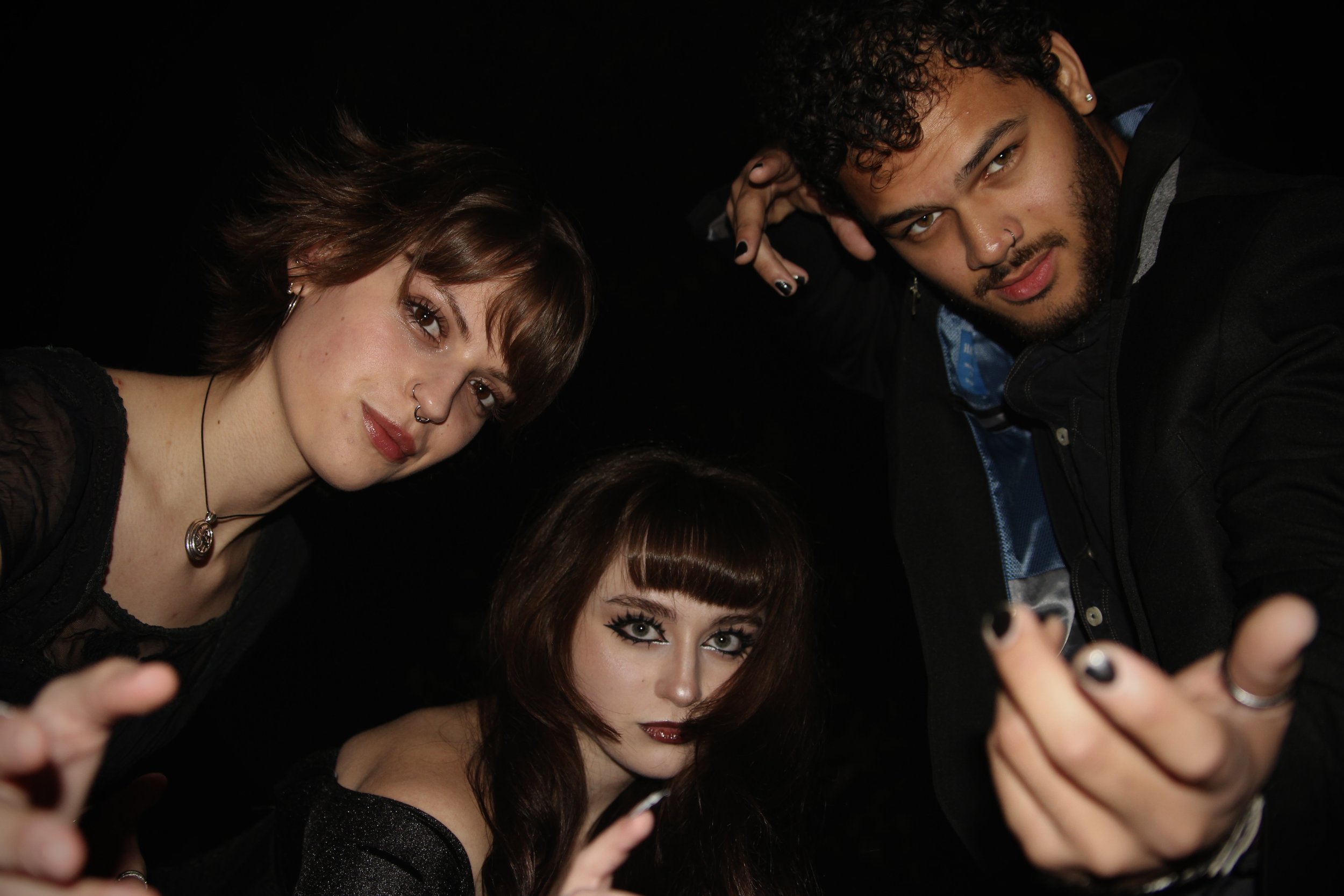The Allure of The Vampire: Do You Know What It Means to Be Loved by Death?
Written by Claire Boumstein
Photography by Claire Boumstein & Tanith Frazier
Modeled by Ellie McCleary, LE Workman, Claire Pierson, Daniel Castillo, & Anna Berkheimer
A man stands on a lonely French stage, his face concealed beneath a gray hood, the audience silent and thrumming with anticipation. He embraces a weeping woman as she sobs over an end that is soon to come. The man puts a hand to her cheek with the softness of a lover and says, in a voice like honey, “No pain.” The woman’s eyes soften, and she eases into the complete understanding of this embrace, this promise. As the man's canines elongate through his tender smile, it becomes apparent to the audience that he is no man at all; rather, he is Death, come to hold her in her last moments, to see her, love her. Do you know what it means to be loved by death?
In this iconic scene from the television adaption of Anne Rice’s “Interview With The Vampire,” the showrunners tackle one of Rice’s most iconic quotes: “Do you know what it means to be loved by death?” The scene depicts a young French woman, Annika, captured by the Theatre des Vampire — a theater troupe of vampires disguised as humans — as her final moments are displayed as a part of the troupe’s closing act to an unaware audience. This scene, along with much of Rice’s work, addresses the allure of vampires and their messages of morality, sexual expression, and all-consuming love.
Inarguably, there is a tone of inherent eroticism with vampiric representation in media. The concept of consuming a person’s blood — a physical manifestation of their life — specifically when it’s done via bite to the neck, is in all ways a similar intimacy and vulnerability to what is experienced with romance. Additionally, these portrayals have often been used as either indirect or direct messaging about embracing one’s sexuality, however that may take form.
As the modern example of the literary vampire forms around us in so many ways, we have seen an uprising in vampires being used as queer icons. Although this is not a new concept, early depictions of vampires and their sexual ambiguity did not come from a loving or progressive mindset; rather, it was most often used as a tool to express just how “other” and unsettling these creatures of the night were. Sexuality was considered taboo, making representation like the seduction of Laura in “Carmilla” by Le Fanu equally condemnable to her craving for blood. That being said, with the growing social acceptance of queer communities and individuals, what was once gay subtext is now being embraced and expressed proudly through forms such as ““Interview with the Vampire,” “First Kill,” “What We Do in The Shadows,” “True Blood,” and even modern portrayals of vampire icons like Dracula, Carmilla, and Renfield. Filmmakers and writers are changing the language — no longer are these characters hidden behind implications. These forms give the audience a clear, concise picture; vampires are gay, and if anything, that’s what makes them more human.
Along with this embrace of sexuality comes the idea that love is consumption. Vampires are often represented as inherently obsessive, and the consumption of what they love and desire — gorging on a person’s blood — addresses both the intimacy and discomfort of deep affection. Cannibalism and consumption have often been used as a metaphor for love and all its deep-seated complexities through many forms of media, and vampires embody it perfectly. It is the idea of loving someone or being loved in totality, about complete understanding and the terrifyingly raw vulnerability of being understood.
Vampires represent a raw state of humanity, stripped of our niceties and social decency. They portray love in all its agony. It’s the torment of loving deeply while wanting so desperately to be loved that deeply in return. This metaphor revels in its popularity because it combines comfort and connection with the unsettling or visceral, and it's a huge part of why vampires are adored.
Vampirism itself has also been used as a metaphor about morality, death, and change. Immortality, after all, is a romanticized denial of change. It’s about putting things on pause — your aging, your growth, your life — and it’s not always for the better. Jason Isbell’s “If We Were Vampires” beautifully uses the message of vampires’ eternal life as a way to come to terms with his own mortality. In this song, Isbell sings that a vampire would overlook the life that we have all been given, because to them it’s nothing but a short blink in an incredibly vast existence. He states that a vampire would laugh at the lovers and not feel the need to empathize or connect with others. Human connection and life’s brevity is what makes existing a million times more precious. There is no beauty to immortality if what makes life beautiful is the change that a vampire's everlasting life denies.
Media representation of vampires calls to the strange and unusual, to those that take a liking toward the shadows and eerie things of the world. But the ways in which we use these once monstrous creatures to find the beauty and rawness of humanity and teach lessons about change, individuality, and love is a brilliant representation of the extraordinary ways in which we change and are changed by media. We’ve turned something that was once viewed only as horrific and terrifying into something beautiful. That is what it means to love and be loved by death, and it’s what is oh-so alluring about our blood-sucking counterparts.




